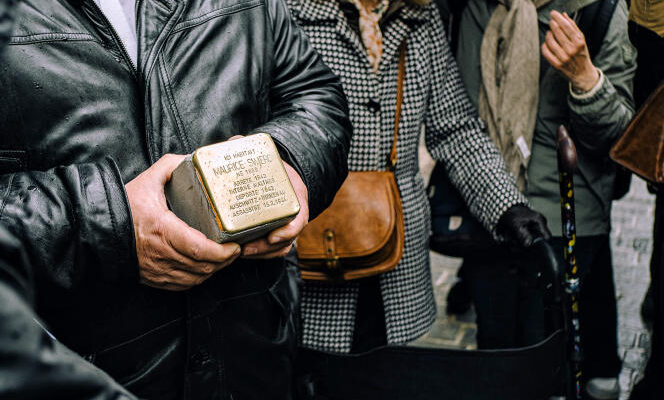They weigh their weight, these little cobblestones of cement and brass. Ten centimeters by ten, and a few words. A name, a date of birth, that of their arrest and the supposed date of their assassination in Auschwitz. That’s all, but all is said. They are called Stolpersteine : literally “stones on which we stumble”, imagined by the German artist Gunter Demnig to whom we owe the idea of this open-air memorial.
President of the Lille-Fives 1942 association, Dominique Leser had two posed on May 12 in the northern city, in front of the white-fronted house where Micheline Teichler lived – 11 years old when she was deported – and her father, Bernard. Three others will be installed in public space in Lille that morning.
This is the first time that the city has joined this memorial initiative launched in 1992. Each time, the ceremony is ritualized. The municipal services previously dug the holes in the sidewalks. All that remains is to recall the names of those who lived there, how they disappeared during the night of their deportation, and to slip the solpersteine in front of their last home, where they will then be sealed into the sidewalk.
“Over time, they shine more and more”
“The gaze of passers-by can only stumble over these Stolpersteine », confides Dominique Leser, for whom the “the fact that we walk on it is not disrespectful”. “Over time, they shine more and more”, he adds, before tell the high school students associated with this ceremony the story of the Teichlers.
In July 1942, a few days after the Vél’d’Hiv roundup in Paris, Micheline and her father were betrayed by a hawker they met at the market. The latter spoke a little Yiddish, enough to give Bernard Teichler confidence. Instead of taking them across the demarcation line, the man handed them over directly to the German authorities, no one knows for what sum, as he will do for around 200 people.
” Ask some Stolpersteine, it is to tell these lives, but also to remember that there were Righteous, people who did not lower their eyes and dared to help”, insists, for his part, the elected Lille Franck Anoh in front of the former fabric store of Maurice Swierc, his great-uncle, who lived with his wife, Rachel, upstairs. They both died in Auschwitz.
Settled illegally in Cologne in 1992
The mayor of Lille, Martine Aubry, admits having “a bit thoughtful” before giving its consent, a year and a half after being requested by Lille-Fives 1942. The association maintains another memory, that of September 11, 1942, the day of the great roundup of Jews from Nord-Pas-de-Calais. Railroad workers from the marshalling yard and local residents, without consulting each other at the start, organized the rescue of around fifty people leaving for the Mechelen camp in Belgium, the last stop before Auschwitz-Birkenau. Among them, 26 children.
You have 44.16% of this article left to read. The following is for subscribers only.
